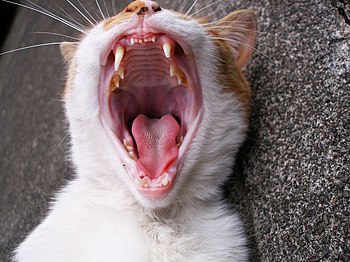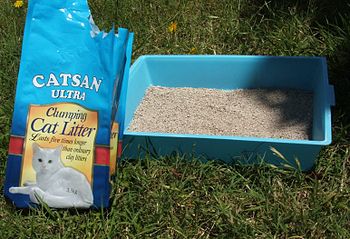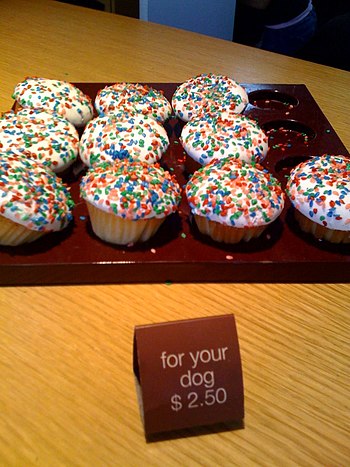 |
| Bilateral hip dysplasia in a Labrador Retriever puppy. The left hip (positioned on the right side in the X-ray) is worse than the right hip, with only slight coverage of the head of the femur by the acetabulum. (Photo credit: Wikipedia) |
Treatments for canine arthritis range from natural supplements using chondroitin and glucosamine, to veterinary prescribed drugs such as Rimadyl and Deramaxx. Studies and actual results have shown that natural supplements can be extremely effective in fighting the effects of arthritis in dogs without the potentially dangerous side effects of Rimadyl and Deramaxx. Before deciding which treatment option is best for your dog, you should observe the signs of dog arthritis.
Signs of Dog Arthritis
1. Limping and general reduced activity.
2. Favoring one or both of the front or back limbs.
3. Morning activity or cold weather makes the dog less active.
4. Difficulty rising from a resting position, especially in the morning.
5. Pain to the touch.
6. Reluctance to jump.
If you suspect your dog has arthritis, you should know the different forms or types of arthritis. The most common disorders are listed below.
Types of Dog Arthritis
1. Osteoarthritis – Also known as canine arthritis or dog arthritis, it is the most common form of arthritis and most easily treated. Develops slowly as the dog ages.
2. Rheumatoid Arthritis - This is an immune-mediated disease and can affect the whole body. Several joints can be affected and the lameness can come and go without notice. Considered a more serious condition than dog osteoarthritis.
3. Degenerative Disc Disease - This is where the discs in the vertebrae develop calcification and become rigid. They become less able to withstand compression. This can lead to a severe injury and paralysis if the discs rupture or become herniated.
4. Stifle Joint Disorder - This is a condition in which the knee and joint become unstable. This is usually from a stretched or torn ligament. This can also cause the joint cartilage to become damaged and inflamed.
5. Canine Hip Dysplasia - This is caused by looseness in the socket connecting the thighbone and hipbone. This development usually occurs when the dog is young but can develop at any age. A common sign is to hear a clicking sound when the dog walks.
Treatment Options
1. Natural Supplements – Most natural supplements use chondroitin and/or glucosamine as its primary ingredient. All of the glucosamine forms originate and are extracted from shellfish. chondroitin is derived from animal cartilage. Many products like Free and Easy for Dogs use glucosamine and chondroitin and combine additional supplements to provide a synergistic effect. Besides glucosamine and chondroitin, some of the more popular and effective supplements added are msm, ester-c, and hyaluronic acid. Many studies have been done which have proved the effectiveness of these supplements in humans. Dog owners have also reported many positive outcomes for their dogs using these natural supplements.
2. Rimadyl & Deramaxx - These drugs are obtained by prescription only. They are called NSAID (non-steroidal anti-inflammatory drug). Rimadyl was introduced by Pfizer Pharmaceuticals in January 1997 to help treat dogs with inflammation and pain associated with surgery or canine arthritis. It is effective but it must be used with caution. Search Google for "What Your Vet May Not Tell You About Rimadyl" for more detailed information. At a minimum, you need to have blood work done to monitor the liver enzymes to ensure your dog doesn't have a toxic reaction to the drugs.
3. Surgery - Surgery can be an easy decision or a very difficult decision. Often, money is a concern and some surgeries like disc surgery can cost around $3,500. Often, the age of the dog has to be considered when making this decision. And the outlook and prognosis are very important. You do not want the dog to suffer unnecessarily. At the very least, you should only consider surgery after ensuring an accurate diagnosis has been made. This may involve taking x-rays and a myelogram. A myelogram is done by injecting dye in the spinal canal to enable your doctor to detect abnormalities of the spine, spinal cord, or surrounding structures.
Summary - Dog Arthritis can be a very debilitating disease if left untreated. Dog owners should pay close attention to their animals and take prompt action when symptoms are noticed. Often a natural supplement is all that is needed to help your dog. Sometimes more aggressive treatments are needed such as surgery. The most important thing is to notice and diagnose the problem and then decide what treatment is best for your dog.
Copyright 2006 William Smith

















